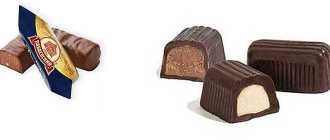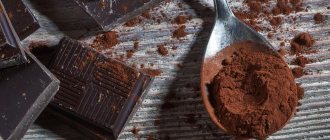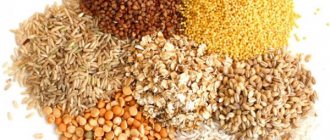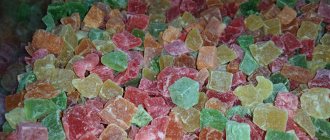What is caramel made from?
The recipe for classic caramel, which dates back to the 14th century, requires the use of only two main ingredients - water and sugar. The mixture was heated, poured into molds, and then cooled.
Modern caramels are also made from sugar, but in the production they additionally use invert syrup - a solution of sugar with citric acid, or caramel molasses. Such components help the sugar mass thicken faster. Food flavorings and dyes are added to candies, which also affect the nutritional value of the finished product.
Lollipops made with molasses contain:
- sucrose – 58%;
- glucose – 10%;
- polysaccharides (dextrin) – 20%;
- maltose – 7%;
- fructose – 3%.
The remaining 2% comes from water.
If invert sugar is used in production, then it occupies 20% of the volume, the remaining 80% is sucrose.
Caramel, whose calorie content on average reaches 360-380 kcal per 100 g, consists almost entirely of carbohydrates, the content of which fluctuates around 90 grams. There are practically no proteins or fats in the composition. The share of each nutrient in 100 g of product is insignificant - less than 1 gram.
Frequent use of lollipops is harmful to the body, as they can provoke:
- rapid weight gain;
- development of carious formations;
- provoke worsening of the condition in patients with diabetes or pancreatitis.
But caramel can also have a positive effect: consuming candy after physical activity promotes a surge of energy. This is due to the large amount of carbohydrates they contain.
Product preparation technology
The essence of the original recipe for making caramel has remained unchanged throughout the history of this delicacy.
It involves heating sugar and water to a certain temperature, after which the syrup is poured into molds and cooled.
In modern industrial production, technology has become somewhat more complicated. Cooks from all over the world began to prepare caramel using starch syrup and special invert syrup.
Invert syrup is a product made from fructose and glucose mixed in equal parts.
In addition, modern industrially produced caramel includes flavorings and thickeners, as well as other substances that extend its shelf life and improve its taste.
Calorie content of different types of caramel
The average number of calories per 100 grams of product is about 380 kcal. Based on this, the calorie content of 1 piece of caramel weighing about 6 g is 22.8 kcal. But this indicator is average: it all depends on the type of product itself.
Lollipops
The brightly colored candies, so beloved by children and adults, consist almost entirely of sugar. This causes a high carbohydrate content: 100 g of candy contains about 97.5 g. Therefore, 100 grams of candy contains a fairly large number of calories - about 390.
With liqueur
Approximately 358 calories.
It is worth remembering that the candy also contains an alcoholic component, which, when consumed in large quantities, can have a harmful effect on the body, especially when using antibiotics or following a diet.
Chocolate
If regular candies can still be consumed in small quantities without fear of instantly gaining extra pounds, then it is better to avoid candy with chocolate filling.
When chocolate is added, 8 g of fat and 1.6 g of protein per 100 g appear in the product. The increase in nutritional value is determined precisely by the addition of chocolate, the calorie content of which reaches 550 kcal per 100 g. However, its content in the filling is small, so the number of calories in the candy still does not reach the level of pure chocolate, but increases from an average of 380 kcal to 427 kcal.
Fruity
But caramel with fruit fillings is considered one of the lowest-calorie types among all similar products. Calorie content fluctuates around 372 kcal. This means that one candy weighing 6 grams contains approximately 22 kcal.
Lipstick
The calorie content of caramels with fondant filling fluctuates at 366 kcal, but the mark can drop to 358 kcal. This is due to the raw materials from which the filling is made. In the production of fudge, not only sugar is used, but also milk, which “dilutes” the carbohydrate component of the sweets. However, with its addition, other nutrients appear in caramel: fat in the amount of 4.6 g and 2.2 g of protein.
Glazed
Chocolate-coated lollipops contain about 390 kcal. However, if natural chocolate is used in the manufacture of glaze, the calorie content of the finished product increases: the figure reaches 400-420 kcal per 100 g. The use of synthetic substitutes allows the calorie content to remain approximately at the level of regular caramel, i.e. at around 380 calories.
The calorie content of caramel per 100 grams depends on the type of sweet product. If, for example, we take Rot Front products, then the calorie content of Moskvichka caramel per 100 grams will be 396 kcal. In a 100 gram serving of sweets:
- 2.6 g protein;
- 9 g fat;
- 79 g carbohydrates.
The composition of the candies includes sugar, molasses, chocolate glaze, condensed sweetened milk, alcohol, cocoa powder, flavoring, stabilizer, and milk fat substitute.
Calorie content of caramel candies in 1 piece. depends on the type of product. So, in one Moskvichka caramel:
- 43.56 kcal;
- 0.29 g protein;
- 0.99 g fat;
- 8.69 g carbohydrates.
Types of sweets and their calorie content
Over the entire long period of existence of sweets as confectionery products, a countless number of their varieties have been invented. Any new combination of components gave the inventor a new taste and a new variety, and as a result, additional benefits. And each type of candy has its own nutritional properties and affects the body in its own way.
A common property of all sweets is a large amount of sugar. It is this that leads to metabolic disorders, tooth decay, many unpleasant diseases, and sometimes food allergies. But it also gives us a good mood and active mental activity.
And the remaining properties are specific to each specific type of candy. Here, for example, are the main types of sweets.
1.Candy caramel.
This type of candy is perhaps the least beneficial for the body, although due to the variety of shapes, colors and tastes, lollipops are very popular among children.
These candies are made from a mixture of sugar and molasses; sometimes corn syrup is used instead of the latter in the production of candies. To give the delicacy different tastes and colors, flavors and dyes, often synthetic, are used. In terms of calorie content, lollipops are not inferior to jelly candies, but unlike them, they contain practically no useful substances.
That is why, apart from the pleasure received from sucking lollipops, it is hardly possible to note any of their benefits. Except, of course, when lollipops are a dosage form of a drug, for example, for the treatment of throat diseases.
Candy caramels contain up to 300 kcal.
Caramels with various fillings up to 400 kcal.
2. Chocolate candy.
These are perhaps the healthiest candies when it comes to a quality product. The benefits of chocolates directly depend on their composition. The fewer unnatural ingredients they contain, such as dyes, flavors, preservatives and others, the better, of course. Chocolates must contain cocoa products.
Today, most often, manufacturers make them from cocoa powder; you can rarely find grated cocoa in the list of ingredients. In addition, chocolate candies may contain dozens of ingredients: dairy products, fats, including vegetable fats, sugar and various fillers.
Good quality chocolates with fillings, when consumed in moderation, will certainly bring more benefit to the body than harm. However, it should be understood that they cannot be cheap. The low price of chocolates can only indicate that they contain low-quality, low-grade ingredients.
Depending on the composition, the calorie content of chocolates can vary from 400 to 600 kcal per 100 g of product.
3. Taffy.
Toffees are made from milk, honey, sugar and butter, so they contain a lot of calories - three hundred kilocalories per hundred grams of toffees. For this reason, if you are on a diet, you should avoid consuming them. But there are practically no proteins in them, which indicates the complete uselessness of toffees for athletes, since all the calories go into extra pounds, and not into muscle mass.
Toffees contain many useful substances, vitamins, minerals and trace elements, animal and vegetable fats and carbohydrates. They are recommended to be included in the diet of people with underweight.
However, if you suffer from liver disease, pancreas disease, if you have had strokes or heart attacks, if you have diabetes, vascular problems, excess weight or gastrointestinal tract, then you should exclude these sweets from your diet, as they may harm your body. They are also contraindicated for children under five years of age, and from five years of age only in strictly limited quantities.
Calorie content of toffees is 443.3 kcal
4. Dairy.
Milk candies are not only tasty, but also healthy, as they are made from condensed milk. Condensed milk, if it is made from natural milk, is healthy. Milk has a particularly positive effect on the condition of bones and teeth, improves their growth and strengthens them. This is most needed for children and the elderly. A child’s body grows and, accordingly, bones and teeth grow, and in order for them to be strong, they need calcium, which is quite abundant in milk and dairy products. And for older people, it is necessary to prevent fractures, which they often have and are quite difficult to heal.
Milk also has a good effect on the digestive system and helps normalize metabolism. It also improves immunity, helps the body remove various harmful substances, regulates acidity, and relieves heartburn. It also has a beneficial effect on the nervous system, helps in stressful situations, and calms (calorizer). It is also useful for insomnia and helps you fall asleep. Therefore, tea with milk and milk sweets will help you calm down and restore strength. It also has a beneficial effect on the cardiovascular system, helps prevent the formation of blood clots, and makes blood vessels more elastic.
The calorie content of milk sweets is 364 kcal per 100 grams of product.
5. Fruity.
Fruit sweets contain sorbitol, which replaces sugar. It is obtained by extracting from stone fruit or algae. The positive effect of sorbitol is that it is able to add sweetness to the product without increasing its calorie content. Sorbitol has other positive characteristics. It is recommended for use by those who have bile stagnation or with a severe cough.
Fruit sweets with sorbitol are an excellent solution to enjoy without gaining excess weight. A sorbitol-based treat is suitable for all family members. Children and diabetics can try them without fear.
Fruit candies also contain pectin. It acts as a thickener. Pectin is a natural product (calorifier). It is obtained from citrus fruits. This substance will help keep your weight normal, restore the body’s metabolic processes and remove harmful cholesterol. The most valuable property of pectin is its ability to rid a living organism of pests that interfere with the proper functioning of the system.
Fruit sweets also contain cocoa. Cocoa powder affects the nervous system, improving mood. Cocoa-based products are recommended for hypertensive patients, as this product helps lower blood pressure. Also, the substances contained in cocoa will give the skin elasticity and youth.
This type of product belongs to the category of dietary food.
The calorie content of fruit candies is 369 kcal per 100 grams of product.
6. Jelly.
In essence, jelly and chewing candies are the same thing, they just have a slightly different consistency. These bright, beautiful sweets with all sorts of flavors quickly won the hearts of big and little sweet tooths. But in order for this delicacy to be not only tasty, but also healthy, you again need to pay attention to its composition. The main components of truly healthy jelly candies are fruit juices or syrups, pectin, agar-agar or gelatin (gelling agents, thanks to which the candies keep their shape), natural dyes, and of course, sugar.
The benefits of caramel
The beneficial properties of caramel include:
- the product increases the level of the happiness hormone, therefore helps to cope with stress, apathy, and depression;
- After intense physical and mental stress, you can quickly restore the body's strength with the help of caramel. This is due to the saturation of sweets with calories and fast carbohydrates;
- In cosmetology and folk medicine, caramel is actively used to prepare masks. Thanks to the addition of this component, the masks make the skin even more velvety and smooth.
Harm to caramel
Of the harmful properties of caramel, it should be noted:
- sweets are saturated with sugar, which damages the integrity of tooth enamel and promotes the development of caries;
- caramel is excluded from the diet in case of diabetes, exacerbations of pancreatitis, cholecystitis;
- You will have to refuse the product if you are prone to edema, as well as with flatulence and bloating;
- due to their high calorie content and saturation with harmful carbohydrates, sweets are excluded from the diet if you are overweight, during a diet and losing weight;
- molasses and fruit acids of caramel contribute to dysfunction in the intestines;
- Some people have an individual intolerance to sweets, which can manifest itself in the form of rashes on the back, chest, and face.
Not everyone, but many sweet tooth lovers are periodically interested in how many calories are in chocolate candy. This is not surprising: most people with a sweet tooth are women who try to watch their weight.
Modern ladies do not need to know the calorie content of chocolates by heart: it is enough to have access to the Internet. The packaging usually also contains such information, but the calories there are given per 100 grams of product. If you are extremely careful about your diet, you may find information about the calorie content of a single candy useful.
Beneficial properties and harm
One of the main beneficial properties of caramel is its ability to soothe the throat in diseases of the upper respiratory tract.
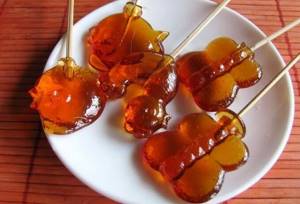
Moreover, what is noteworthy is that not only special medicinal candies, which are the brainchild of pharmaceuticals, have a similar effect, but also ordinary burnt sugar, even prepared at home. When the caramel is absorbed, saliva is released, which softens the inflamed mucous membrane, as a result of which inflammation and pain go away faster.
Caramel is also an excellent remedy for hypoglycemia, in other words, a sharp decrease in blood glucose levels. A sweet treat can be used as an emergency remedy for mild forms of this pathological condition.
However, at the same time, sugar, which is the basis of this product, can cause serious harm to human health.
This delicacy should not be abused by people who are overweight and trying to get rid of extra pounds. The fact that caramel is a high-calorie product speaks for itself.
Many types of sweets contain fruit acids. Therefore, overuse of this delicacy can lead to dental problems.
Products containing molasses and fruit acids can provoke dysfunction of the intestinal environment and also contribute to the development of pathogenic microflora. This is fraught not only with manifestations of dyspepsia, such as flatulence, pain and diarrhea, but also with the appearance of a rash on the face, chest and back.
Glucose entering the body in large doses is a serious burden on the pancreas. Therefore, in case of diseases of this organ, it is better to refuse delicacies.
According to data obtained by scientists during recent studies, the information that sweets stimulate the brain and sharpen cognitive abilities is not entirely true. The thing is that subconsciously a person perceives dessert as a kind of reward for his work. Therefore, the brain seems to receive a signal: “That’s it, stop working, it’s time to rest.” That’s why you shouldn’t get too carried away with eating sweets, including caramel, trying to “stimulate” yourself before work.
Calorie determination
It's no secret that chocolates contain a lot of calories. Dark chocolate has the least amount of calories, while milk chocolate has the most calories. 100 grams of chocolates contain from 450 to 600 kcal. Fats make up 54%, carbohydrates – 36%, proteins – 10%.
The most calories are contained in milk chocolate candies with nut, waffle, cream filling, condensed milk, and halva (550–600 kcal per 100 g). Dried fruits and berries (prunes, dried apricots, etc.) in chocolate glaze (350–450 kcal) will be less nutritious; the lowest calorie chocolates are jelly, soufflé, and bird's milk (250 kcal).
Determining your norm is very easy. It is enough to read the label, which indicates the weight and energy value, divide by the number of candies and find out how many calories there will be in one piece. When making homemade candies, you can calculate the number of calories per unit based on the calorie content and weight of the products used.
Piece calorie content of popular chocolates
Preparing soft caramel
To make a soft, sweet and salty caramel, you will need the following ingredients: 300g sugar, 335g fresh cream 30% fat, 65g butter and a teaspoon of salt.
Divide the sugar into six 50 g portions. Pour the first portion of sugar into a saucepan with a thick bottom and place on fire. Melt, then add the next portion to the pan. Please note that you cannot stir! This way melt all the sugar.
Place the cream on the fire and heat almost to a boil, but do not boil. Remove sugar from heat, add salt and butter, then mix thoroughly. After this, pour hot cream into the syrup in small portions, stirring constantly.
Place the caramel on the fire and heat over low heat until it takes on the color of milk chocolate.
After this, remove the pan from the heat, pour the contents into the mold, cover with cling film and refrigerate for a day.
Historical excursion
Chocolate appeared about 150 years ago. It was consumed as a drink, then as a medicine. With the help of cocoa beans, people were treated for anemia, loss of strength, and even tuberculosis.
The further history of this confectionery product began to accelerate every year. The product has become of higher quality and diversified, new tastes and aromas have appeared, and entire generations of chocolatiers have been formed. Each of them contributed to the improvement of this product. Today everyone knows the most worthy companies and well-known manufacturers. These include Belgian, Swiss, French manufacturers. Our country also has its own veterans. Among them are “Babaev Factory”, “Red October”, “Rot Front”, etc.
How can you spend the calories received after eating chocolate candy (approximate data)
Production Features
The raw material for making the delicacy is the ripened fruits of the cocoa tree, which grows in America, Indonesia and Australia. They are removed, sorted, fried, crushed and sent into powder form for chocolate production. Oil is also extracted from cocoa beans by pressing.
When making chocolates, powder, powdered sugar and cocoa butter are used. For a milky look, add milk or cream. The raw material, brought to a homogeneous consistency, is poured into special molds and the filling is added. All that remains is to put the candies in boxes or wrap them in colored wrappers.
You can prepare the treats yourself. To do this you will need cocoa powder, sugar, flour, milk, cocoa butter or butter and a filling of your choice. In this case, you will also know how many calories are in the candy.
To eat or not to eat?
Chocolate products can be beneficial when consumed in moderation. Thus, the famous long-living Frenchwoman Jeanne Calment was very fond of this confectionery product. Many vitamins, microelements, and beneficial amino acids allow the body to fight depression, improve mood, and strengthen memory.
The joy hormone serotonin, produced by the body when eating chocolate, allows a person to escape from the hustle and bustle and problems. Children should also be periodically pampered with sweets, since pleasure is especially important in childhood.
The dangers of chocolate can only be discussed in terms of the amount of sweets consumed, which must be controlled. You should also pay attention to candies with alcohol, which are contraindicated for children, pregnant and lactating women. Drivers are also advised to be careful with this dessert.
If you are one of those with a sweet tooth who is very worried about their figure, but cannot refuse chocolates, you have one reasonable way out of the situation: burn calories with physical activity. To do this, just go for a walk some time after drinking tea (or, if you live on the ninth floor, check your mailbox without using the elevator).
Do you like candy? - Fine. Curious about their calorie content? - Amazing! This means that sweets will only be a useful product for you because you decided to control their quantity.
If you are specifically interested in the calorie content of candy, then you should understand that different candies have completely different calorie content. It all depends not only on what material the candy is made of (chocolate, toffee, lollipop, icicle), but also what filling the candy has. In view of this, we simply cannot physically list for you the calorie content of all existing candies, because they all differ in some way - composition, weight, filling, so we will give you only examples of the most common candies, indicating the approximate weight and their calorie content.
Data per 100 grams of candy product.
Therefore, make a basic calculation based on the weight of 1 (one) candy. Weight is indicated in each section. Do you want to lose weight? - Count your calories.
Candy type prunes in chocolate
(Weighing from twenty-five to eighty-five grams).
Has a caloric content of 343 (three hundred and forty-three) kilocalories.
Candy "Golden Step"
(It also comes in different weights - from twenty to ninety-two grams).
The calorie content of one hundred grams of such sweets is 488 (four hundred eighty-eight) kilocalories.
Candy "Grand Tofi"
(It can weigh from seven to thirty-one grams).
Calorie content is 452 (four hundred fifty-two) kilocalories.
Candies "Squirrel"
(They weigh from eleven to fifty-eight grams).
Calorie content – 531 (five hundred thirty-one) kilocalories.
Candy "Spark"
(The weight of Spark candy with prunes ranges from twenty-five to ninety-seven).
Calorie content – 389 (three hundred eighty-nine) kilocalories.
"Bird's Sweetness"
(The weight of Bird Sweet candies ranges from seventeen to seventy-two grams).
Calorie content – 424 (four hundred twenty-four) kilocalories.
"Martin"
(“Swallow” ranges from fifteen to sixty grams).
The calorie content of this candy is 400 (four hundred) kilocalories.
"Levushka"
Levushka is about the same weight - 386 (three hundred eighty-six) kilocalories.
Fruit caramel – “Icicle”
As for fruit caramel, which is most often popularly called “Icicle”, their calorie content is not too high (of course, relative to all sucking candies).
For one hundred grams of candy - 300 (three hundred) kilocalories.
And if you buy those that do not contain sugar, the calorie content is even lower. Especially such lollipops can be found in the pharmacy.
There are no people in the world who don’t love candy!
Sweets are an integral and very important part of our life.
Sweets have an amazing ability to relieve bad mood.
Scientists have also proven that sweets act on the body as an antidepressant.
It is not surprising that in the most difficult moments of her life a woman is ready to throw herself on cakes, ice cream, and chocolates.
The fact is that after eating these sweets our souls actually feel a little lighter.
True, then all these sweets are deposited on the sides, stomach and thighs, the most problematic areas. And despite the fact that sweets, especially chocolate, contain a substance that helps the formation of the joy hormone in our body, after eating sweets we can become depressed again when we see how harmful it is to our body. And this can simply cause a vicious circle - we kill depression with sweet foods, and sweet foods are stored as fat in our body, which then causes depression in us.
However, there is one “But”
In addition to the fact that sweets are not a very healthy product for teeth, because they affect the formation of caries, they are also the number one enemy in the fight against excess weight. That is why most existing methods for losing weight completely exclude the use of such sweets from their nutritional diet. However, if you try really hard, you can find some diets that allow a small amount of sweets. However, most often these diets are based on counting the calories consumed daily.
Today you can easily find a calorie table on the Internet. Actually, most sites focused on dietary topics and weight loss topics can offer you so-called calorie calculators or weight loss counters.
From the life of caramel
Caramel is rightly called the queen among all the sweets in the world. The taste of this delicacy has been familiar to us since early childhood. Caramel is used as a separate product; it is added to baked goods and desserts, coffee and hot chocolate. It serves as a flavoring agent for many carbonated and soft drinks. What is the secret of caramel, and how did ordinary boiled sugar gain worldwide recognition?
History of caramel
The history of this delicacy goes back to ancient times. The first mentions of caramel appeared more than three thousand years ago in China and Greece. To prepare it, they used barley molasses syrup, which was boiled over low heat until it became a sticky, viscous mass.
But ancient sweets were very different from modern versions of caramel both in taste and composition. The molasses had a bitter taste and an unpleasant aroma. A delicacy similar to today's caramel was first prepared in India only 500 years later. This is due to another significant fact: it was 2500 years ago that the Indians learned to obtain classic sugar from the sugar cane plant.
By the way, the name itself came to us from Latin. Cane sugar, one of the most popular ingredients in caramel production, is called cannamella in Latin. At first, the sweet mass of boiled sugar was called that way. But over time, the word changed its form.
According to legend, the caramel turned out completely by accident. The Dalit caste—“untouchable Hindus who occupied the lowest rung in the hierarchy”—worked on a sugarcane plantation. After the stems were sent for processing, the Dalits collected the fallen cane leaves. There was nothing special to eat, so the Indians fried these leaves over a fire. As a result of this heat treatment, something similar to what we call caramel today was obtained. This was soon noticed by more senior plantation workers. This is how the ancient method of making caramel began to spread throughout the world.

Sugar cane plantation
Very soon the newly invented delicacy reached the Roman Empire. There, sugar was immediately “classified” as a medicine.
For example, the ancient physician Galen prescribed candied fruits and burnt sugar as medicine to his patients with indigestion and nervous diseases.
A new round in the history of caramel occurred in the 14th-16th centuries. Then European confectioners decided to experiment with adding sugar to their products. This product was still considered rare and very expensive, so caramel was used to decorate the dishes of only very rich families, including royal ones.
Caramel reached our lands in the 15th century. It was immediately called “lollipop” because the translucent solid products made from burnt sugar really resembled ice. Cakes made from droplets of frozen sugar syrup were attached to thin wooden sticks. This type of candy can be found on store shelves today.
Then the production of sugar became widespread, its price fell, and therefore caramel products became more affordable. In the 17th and 18th centuries, cooks came up with the idea of covering fruits and nuts with liquid caramel. This delicacy did not require much effort in preparation, and the cost remained low, so it began to be in wide demand among different segments of the population.
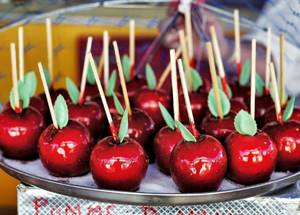
1899 is the year the first medicinal caramel appeared. If previously sugar itself was called medicine, then this year the German pharmacist Karl Soldan decided to add medicinal herbs to it. The idea came to Soldan by chance. His little daughter fell ill, and he could not convince her to drink a medicinal decoction. Then the pharmacist decided to cheat: he added a large amount of sugar to the herbal decoction and boiled everything again. The syrup was poured into molds, and after hardening, it was offered to the baby. The child happily accepted the treat.
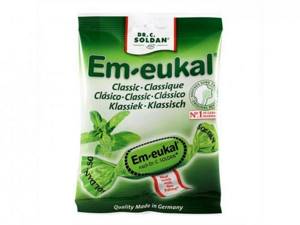
Those same medicinal lollipops of the Dr.C.Soldan's brand
Types of caramel
Today there are a huge number of types of caramel. But if we single out the main categories, we get two of them: hard and soft caramel. The first category is used for making sweets and lollipops, and the second - as an additive to confectionery products.
The main ingredient of caramel today is syrup. Depending on the syrup, caramels are distinguished based on:
- glucose (or grape sugar);
- maltose (malt sugar);
- sucrose (cane sugar);
- fructose (fruit sugar).
There can be many types of candy caramel. They depend on the additives that are included in the composition. It could be:
- fruity;
- liqueur;
- berry;
- chocolate;
- mint and other caramels.
Caramel production
Several thousand years have passed since the first appearance of caramel, but the essence of the production of this sweetness has not changed. The treat is still based on two ingredients: sugar and water. The principle of making caramel is simple. Sugar is poured into water, then the cured mixture is heated to high temperature and thickens. The syrup is poured into different forms and cooled.
On an industrial scale, caramel is produced in a more complex way. In production, starch molasses and inverter syrup are used (fructose and glucose are mixed in proportions 1:1).
Depending on the manufacturer and taste of the candies, their composition may include milk, chocolate, fruit, condensed milk, and cocoa.

Caramel production at the factory: the photo shows thickened syrup, which is then crushed into individual candies
What is caramel made of?
We have dealt with the main ingredients and additives in the form of flavorings. Let's talk about the chemical composition of caramel. Many people believe that such sweetness is just sugar, so it cannot contain useful substances. But that's not true. Every 100 grams of caramel includes:
- vitamins (E, PP, K, B12, C, pantothenic acid, choline);
- macro- and microelements (iron, phosphorus, potassium, sodium, magnesium, calcium, zinc, fluorine, copper).
But the calorie content of caramel is really high - every 100 grams contains an average of 378 calories. Caramel nutrients are distributed as follows:
- carbohydrates - 92 grams;
- proteins - 1 gram;
- fats - less than 1 gram.
The benefits and harms of caramel
You should not believe rumors that sweets (including caramel) are completely harmful to your health. The main benefit of caramel is its ability to “treat” a sore throat. Moreover, this applies not only to pharmaceutical lollipops. Even regular burnt sugar can help with sore throats and colds.
The fact is that caramel requires a large amount of saliva to dissolve. And saliva can soften the inflamed mucous membrane of the throat. Due to this, pain is noticeably reduced.
Caramel is also harmful. Abuse of this sweetness can lead to:
- To excess weight due to high calorie content.
- To problems with teeth due to the content of fruit acids.
- To dysfunction of the intestinal environment due to acids and molasses, which, in turn, leads to flatulence, abdominal pain, and skin rashes.
If you suffer from pancreatic diseases, then it is better to avoid caramel. Glucose contained in the composition can aggravate health conditions.
How to choose a high-quality and tasty delicacy
The range of caramels today is so large that choosing just one product is quite difficult. To make the delicacy not only tasty, but also healthy, follow a few rules:
- Soft caramel is less harmful than its hard candy counterpart. It is not so harmful to teeth and is more saturated with oxygen.
- The color of the candy is also an important factor. Bright shades look interesting, but they can hardly boast of a good composition. Most likely, the acidic colors were due to the addition of unnatural dyes. It is better to choose beige or brown candies.
- The filling matters too. Ideal options are chocolate, fruit or crushed nuts.
- It’s very easy to understand that candy is nearing its expiration date. If the surface has become damp and sticky, then it is better not to eat such sweets.
You can find many options for high-quality and tasty caramel here - Caramel candies.

Conclusion
The main thing when eating caramel is not to overdo it with the amount. In small doses, sweets will bring you not only benefits, but also a great mood from eating such a tasty delicacy.
Back to list
Attention! Candy and a woman's age!
The fact is that the amount of calories consumed (the optimal amount) will be different for each age!
From 18 to 20 years old
If you are in the age group of eighteen to twenty-nine years, then you can consume about 2200 (two thousand two hundred) calories per day.
From 30 to 50 years
If your age is from thirty to fifty-nine, then the amount of calories allowed for you should not be more than 2000 (two thousand) kilocalories per day.
Over 60 years
Women over sixty should not eat more than 1800 (thousand eight hundred) calories daily.
Diets vs candy!
As we have already said, most modern dietary methods for losing weight categorically prohibit the consumption of any sweets, we are not even talking about chocolate or sucking candies.
However, it is all the more difficult for us to fight this because when we come to the store, it becomes especially difficult for us, because in the markets there is such a huge variety of these sweets (both in appearance and in their content) that it is so difficult to restrain ourselves within limits!
Making hard caramel at home
Caramel is a delicacy that can be prepared at home. Dealing with this is not at all difficult; you just need patience and minimal skill.
First of all, prepare a saucepan with as thick a bottom as possible.
The ingredients you will need are: one cup of sugar, a quarter cup of water and half a teaspoon of apple cider vinegar, which will help prevent sugar from crystallizing.
All ingredients need to be mixed and then cooked over very low heat. It is believed that the readiness of caramel can be checked by dropping a little syrup into a glass of water - you want it not to spread, but to resemble chewing gum, that is, stretch. Please note that it is better to undercook the caramel than to overcook it - otherwise you will end up with regular burnt sugar.
If you are going to sculpt some figures from caramel, the main thing is not to let it harden quickly. To avoid this, after removing the saucepan from the heat, place it in a large diameter container with hot water so that the contents harden as slowly as possible.
Please note that you can immediately add nuts or chocolate pieces to the caramel. This must be done before removing it from the heat. Don't forget to mix well.
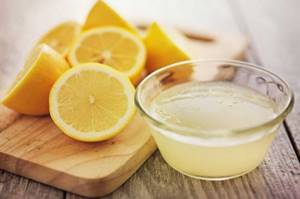
To avoid sugar crystallization, cook the caramel over very low heat and do not stir until the sugar has completely dissolved. Apple cider vinegar or lemon juice, which can be added to the caramel, will also prevent the appearance of sugar crystals.
If you have some skill, you can make caramel without using water. To do this, melt two glasses of sugar over high heat, stirring continuously. When the sugar begins to become liquid, reduce the heat and continue stirring. Once the sugar has melted, reduce the heat to low and continue stirring until completely dissolved. Pour the finished syrup into silicone molds.
It's hard to live without sweets!
It is especially difficult if you have already chosen your favorite type of candy and are constantly forced to contemplate it on store shelves at a time when you have just started following a certain diet.
Although it is worth noting that there are still diets during which you can occasionally make small deviations from the classic scenario and eat just a little sweets, however, even here you will have to take into account how many calories you have eaten and how much you can still eat.
So, you can’t live without sweets, but how passionate do you want to lose weight?
There is nothing wrong. Just divide your nutritious diet into parts, carefully count all the calories so as not to fall behind the schedule, and then simply replace some product with the required amount of candy.
So you can easily combine your favorite treat with dietary nutrition.
4.7 out of 5
Ah, sweets, beloved and desired since childhood! There are probably few people who would say with a clear conscience that they don’t like candy. And those who are on a diet and limit themselves in everything, and especially in sweets, sometimes simply break down. But is it necessary to mock yourself like that? It is enough to find out how many calories are in the candy and enter it into the menu, reducing the number of other dishes. It’s better to eat them little by little all the time than to eat half a kilo at a time.
Many people cannot imagine how they can live without sweets, and it is unimaginably difficult for them to resist the temptation. It is especially difficult to restrain yourself in a store where an incredibly tasty assortment is presented. The candies are so varied in taste that you really want to pamper yourself with them!
Unfortunately, even the calorie content of 1 candy is not small at all, so for people who are counting calories and are in the process of losing weight, it is very important not to get carried away. But you should still have fun losing weight! You can eat this sweet occasionally - but in moderation, maintaining balance, being aware of the effect of different sweets on our body. For example, if the calorie content of cow candy and the calorie content of bird's milk candy are approximately the same, then the calories in chocolate candy are much higher.
The benefits and harms of sweets
When talking about the benefits of sweets, it is worth understanding that the positive effect of these sweets will come to naught if you abuse them or eat them in large quantities.
Naturally, the most obvious positive property of sweets (no matter whether they are chocolate or just candy) is their fight against seasonal depression or simply bad mood.
The benefits of chocolate candies are determined by its antiseptic effect. That is, by consuming natural chocolates consisting exclusively of dark chocolate, our body will be easier to cope with inflammatory processes and various infections.
Sweets contain a high content of carbohydrates, which gives us strength and good health for the whole day. But there is also a negative side to such a saturated carbohydrate content, this is a negative effect on weight. Namely, high calorie content provokes the development of obesity or excess weight gain.
It’s true that almost every one of us heard in childhood from adults advice not to eat a lot of sweets, otherwise your teeth will deteriorate. There is truth in this; most candies can cause tooth decay. Chewing candies and lollipops have a particularly harmful effect on teeth.
Chocolate bars can be addictive, and the prohibitive calorie content in this product, if consumed frequently, can lead not only to excess weight, but also to gastritis.
If the candy is brightly colored, it means it contains artificial dyes, which can cause allergies and other diseases associated with the gastrointestinal tract.
Not everyone, but many sweet tooth lovers are periodically interested in how many calories are in chocolate candy. This is not surprising: most people with a sweet tooth are women who try to watch their weight.
Modern ladies do not need to know the calorie content of chocolates by heart: it is enough to have access to the Internet. The packaging usually also contains such information, but the calories there are given per 100 grams of product. If you are extremely careful about your diet, you may find information about the calorie content of a single candy useful.
Various candies: calorie content
Let us remind you that the calorie content or energy value of a product is the amount of energy that is released in our body during the digestion process. Therefore, to burn extra calories, you need to expend more energy by doing physical activity. Or avoid excess calories in the body, for which there are calorie tables.
As already mentioned, the calorie content of sweets is high.
So, in Dirol candies there are 67 kcal, and in marmalade there are already 160 (per 100 g). Raffaello is very high in calories - as much as 615 kcal.
However, when counting the number of calories, it is more convenient to focus on the calorie content of 1 candy.
So, the calorie content of bird's milk candy is 444 kcal per 100 g, 53 kcal in 1 piece. The calorie content of cow candy is 364 kcal in 100 g, and 52 kcal in 1 piece.
Calories in chocolate candy (with cream filling) - approximately 523 per 100 g, almost 100 kcal in one piece
.
As for other sweets and candies, their calorie content can also be calculated individually:
- Raffaello 62 kcal;
- USSR ice cream 215 kcal;
- Teddy bear 80 kcal;
- Fruge with prunes 56 kcal;
- Meller (iris) 14 kcal;
- Skittles (dragée) 5 kcal;
- M&M's 3.33 kcal;
- Chupa Chups (candy) 57 kcal;
- Orbit without sugar (watermelon lollipop) 6 kcal;
- Kara-Kum 74.51 kcal;
- large Snickers (95g) 502 kcal;
- small Snickers (55g) 280 kcal;
- large Sars (73g) 331 kcal;
- large Picnic with walnuts (55 g) 261 kcal;
- small Milky Way (26 g) 118 kcal;
- large Nesquik (45 g) 219 kcal;
- small Nesquik (28 g) 140 kcal;
- grilled meat 60 kcal;
- Fruit and Nut chocolate bar with hazelnuts (90g) 500kcal, 1 slice (3.75g) 20.8kcal.
Candy calorie table
| Candies | Proteins, g | Fats, g | Carbohydrates, g | Kcal per 100 g |
| Barberry | 96 | 370 | ||
| Bars | 11 | 30 | 53 | 514 |
| Squirrel | 9 | 33 | 53 | 538 |
| Cornflowers | 3 | 13 | 74 | 412 |
| Inspiration | 6 | 34 | 55 | 541 |
| evening call, evening Bell | 11 | 34 | 49 | 542 |
| Chocolate covered roast | 5 | 27 | 65 | 509 |
| Crow's feet | 2 | 7 | 88 | 409 |
| Duchess | 96 | 373 | ||
| Golden domes | 6 | 31 | 56 | 519 |
| Iris "Golden Key" | 3 | 8 | 82 | 395 |
| Iris "Kit-kis" | 3 | 12 | 77 | 416 |
| Lemon caramel | 94 | 362 | ||
| Mint caramel | 97 | 365 | ||
| Fruit and berry caramel | 93 | 360 | ||
| Strawberries and cream | 1 | 1 | 92 | 362 |
| Cranberries in sugar | 1 | 96 | 384 | |
| Cow | 6 | 33 | 55 | 541 |
| Little Red Riding Hood | 7 | 29 | 58 | 515 |
| Dried apricots in chocolate | 5 | 16 | 56 | 386 |
| Martin | 3 | 10 | 77 | 398 |
| Lollipops | 97 | 389 | ||
| Mask | 9 | 31 | 54 | 523 |
| Dream | 94 | 364 | ||
| Teddy Bear | 6 | 31 | 59 | 529 |
| Bear in the north | 8 | 32 | 55 | 529 |
| Muscovite | 3 | 9 | 79 | 394 |
| Autumn Waltz | 11 | 34 | 49 | 537 |
| Cockerel - golden comb | 7 | 36 | 57 | 530 |
| Cancerous cervixes | 2 | 8 | 87 | 411 |
| Raffaello | 9 | 48 | 37 | 615 |
| Daisies | 3 | 14 | 74 | 419 |
| Soufflé in chocolate | 2 | 18 | 58 | 406 |
| Truffle | 5 | 35 | 55 | 548 |
| Halva in chocolate | 15 | 33 | 44 | 528 |
| Citron | 1 | 18 | 82 | 389 |
| Prunes in chocolate | 5 | 20 | 50 | 390 |
Calorie content of cakes
Speaking about the calorie content of sweets, it is difficult not to mention the calorie content of equally favorite cakes, as well as cookies.
- Maria (cookies) 48 kcal;
- For coffee (cookies) 43 kcal;
- Kontik (cookies) 112 kcal;
- Muff with cream (cake) 145 kcal;
- Basket with protein cream (cake) 212 kcal;
- marshmallows made from two halves 135 kcal;
- 1 half of chocolate covered marshmallows 145 kcal;
- jelly bar in chocolate 88.8 kcal;
- dark cracker Veronica (5 pieces 10 g) 47.8 kcal;
- Nicole (cookies) 48.3 kcal;
- Nut (cookies) 118.72 kcal;
- Anniversary traditional (cookies) 55.56 kcal;
- Anthill (cake) 298.9 kcal.
As can be seen from the given values of the calorie content of sweets and cakes, even a small piece has a high energy value, not to mention the significant content of fat and harmful carbohydrates. Therefore, everyone who cares about their figure and is counting calories consumed per day should be very strict about the desire to indulge in sweets and not allow the norm to be exaggerated.
Popular articles
Losing weight cannot be a quick process. The main mistake of most people losing weight is that they want to get amazing results in a few days on a starvation diet. But it didn’t take a few days to gain weight! Extra pounds...

